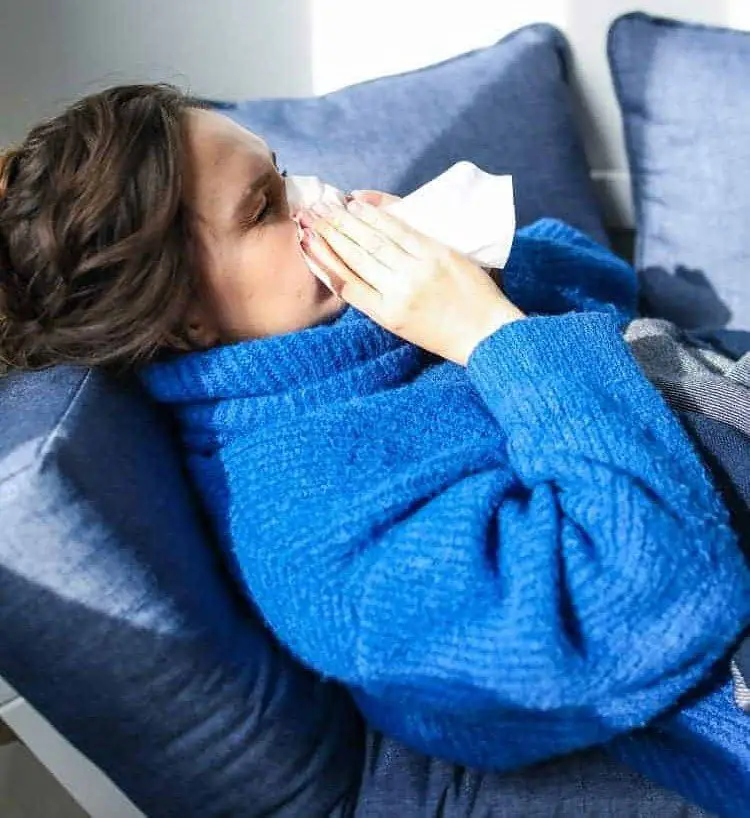It’s unpleasant, painful, and potentially unhealthy — that mucus plugging your nose is driving you bonkers, and it’s just not going anywhere! And you’re probably wondering what does a nasal mucus plug look like? Nothing’s worse than a sore nose.
Breathing becomes such a job that every two minutes, you keep blowing your nose. Besides, you can even get watery eyes, even a cough, grippe, and, of course, a stuffy nose is almost intolerable.
You would ask if the sinus mucus plug would be eliminated at home?
Luckily for you, you’re not going to have to suffer from all this because we have answers to your irritating little dilemma.
I’m also going to inform you what causes your suffering and how you can prevent your nose from being clogged with all the gooey stuff the prevents you from enjoying your life in harmony.
But before that, what’s all this stuff in my nose?
The Mucus’ Function

Though your cold may have come from nowhere, the substance in your nose has been around all this time – it’s called mucus, and your mucous membranes creates it.
It was still there. In reality, it’s working for your body’s filtering system.
How is that? Like an air purifier, the mucus in your nose absorbs atmospheric toxins, such as allergens, spores, fomites, and even particles, so that it does not enter the lungs or any other part of the body.
Besides, the mucus serves as a defense system against foreign contaminants so that you don’t get sick.
The maintenance of lung function includes mucus. The secretion of lungs naturally includes professional scavengers and antimicrobial substances. Mucus captures, engulfs, inhaled spores, cell waste, and dead and aged cells and extracts them.
Cilia-beat called microscopic hair quickly produces a mouth well motion, and all captured particles are swallowed or sputum to the back of the throat.
If the mucus has always been around, then why am I so uncomfortable right now?

Perhaps the mucosal lining does a little overtime and gets sore and bloated.
If the atmosphere produces so much dust or pollen, the mucous membranes get over-stimulated.
This allows them to create a much larger amount of mucus than you require, resulting in the mucus leaking out of your nose in what is called a postnasal leak.
It is also the term we use where the mucus sticks up your nose, creating breathing problems for you.
Typically postnasal drip is characterized by:
- Sore throat
- Respiratory complications
- Frequent chewing and throat clearing
- And, of course, the mucus will clog up or run down the nose
Typically, you experience these symptoms when you have an allergic reaction or when you have a cough or flu.
They may even be caused by certain factors in your lifestyle, such as smoking, eating spicy food, or drinking too little water.
Where you live can also be a factor in how often you have a stuffy nose. Residing in bustling cities with a steady stream of traffic is simply a nightmare for your mucus membranes.
An overly dry climate can also make your mucosal membranes easier to dry, resulting in thick mucous membranes that are twice as hard to breathe.
How are mucus plugs caused?
Several factors may lead to mucus plugging in people with ALS. Among them, others include:
- Be sedentary. Reduced mobility and lack of activity contribute to insufficient ventilation from lower to upper airways.
- Weak abdominal muscles and diaphragm. Cough efficacy is compromised because the lungs do not extend entirely, and stomach muscles fire.
- Glottic activity is reduced or incomplete. If the vocal cords are damaged or bypassed by a tracheotomies tubing due to bulbar muscle weakness, a person can not produce adequate chest pressure to induce a significant toxic effect.
- Dehydration, Inadequate ingestion of fluids may lead to thicker mucus through the mouth or a feeding tube.
- Pneumonia drain. The development of an airway will induce more mucus in the pulmonary system. Moreover, if a person respires via a tracheal tube, they bypass the nose, which has the purpose of burning, humidifying, and filtering the inhaled air.
Preventive techniques
- Suitable hydration. When a human breathes with the aid of a mechanical ventilator and a tracheotomy tube, sufficient ventilation is much more critical—using a heat-and-moisture exchanger (HME or artificial nose) during the day for longevity and a heated humidifier while the person sleeps at night.
- Mechanical lung enlargement and breathing exercises. Incorporate the use of a Cough Assist or Critical Cough machine at least once or twice daily. They can be used in automatic mode to emit a sigh at inhalation followed immediately by a negative pressure breath that can transfer mucus into the opening of the mouth or trach drain. In manual mode, a person may communicate with a caregiver to take a sequence of smaller, stacked breaths to enlarge the lungs, accompanied by a separate collection of smaller, mechanical coughs. Some people find this approach more relaxed and effective later on. Mechanical stretching of the lung and breathing equipment can and should be used with a tracheostomy tube.
- Manually helped cough (abdominal thrust or Heimlich seated). This low-tech procedure can be used in combination with or independently of mechanical coughing. Technical: be in a gently reclined position. Have the caregiver put both hands over the abdomen of the person just below the navel in the form of a “V.” Using the fat pad beneath the thumb as it is smoother.
- A handheld suction device should be sufficient to trap any mucus that has been transferred to the trach tube or the back of the mouth.
- Manual sighs or compressed breaths may be delivered with a manual self-inflating breathing bag (‘Ambu’s’ bag). Manual bag and abdominal thrust procedures can be easily used when a person thinks they are coughing on a mucus plug.
How to remove the sinus mucus plug from your home?

Enhance your lifestyle
As described above, if you drink enough water and stay away from beverages that cause fluid loss (think about caffeine or alcohol) and even avoid smoking, you will dramatically decrease the chances of clogging the airways.
Your nose is going to thank you!
Using a humidifier
Since living in a dry atmosphere will irritate your mucous membranes, having a humidifier in your home will help to provide sufficient moisture for your indoor environment.
If you live in a relatively dry area, check out this guide to find out which humidifier is appropriate for you.
Read more on Best Humidifier For Eczema Reviews Of Our Therapeutic Picks Both Adults And Babies
Keep free from irritants
Keep away from potential irritants as well.
If you do not subject yourself to allergens or areas with a heavy concentration of pollen in the air, you will find that the risk of scratching the mucous membranes have reduced.
Yet my signs have now come to light. What am I going to do to get rid of the stuffy nose?
[Read More on House Smells Like Cigarette, But We Do Not Smoke: Easy Fixes]Use a saltwater gargle
Before running for your medicine cabinets, try a simple saltwater gargle. It’s been proven to draw out excess water from your tissues and can reduce your chances of further infection.
Use a nose Spray.
You can try a nasal spray that reduces your mucosal mucosa inflammation. By the end of the day, you will use them to clear your airways.
Go to get a massage
There are even more unorthodox ways to clear your nose – if you have too many problems breathing, consider simulating the normal flow of fluid through your nose with a massage.
Using your fingers, press your collarbones against the dip to facilitate the downflow of mucus inside your mouth.
If you do it right, you can feel the urge to clear your throat and remove the blockage from your nose, if only temporarily.
Using prescription medications
If none of these works for you, then maybe drugs are the only way to go, then you can consider the following over-the-counter medicines:
Decongestants remove the nose’s heavy mucus, but overuse can lead to side effects such as dizziness and high blood pressure.
Antihistamines can overcome allergy symptoms.
Expectorants make the mucus finer, promoting the evacuation from the nose.
Read more on: Best Air Purifiers for Allergies and Pets
Additional approaches
Another way to make your molecules flow smoother is to breathe a warm towel (use a sleek towel to protect your nose from irritation), heat a pot of water, and breathe in it.
Conclusion On What Does A Nasal Plug Look Like, And Possible Remedies At Home.
You can think of a humidifier as a permanent fixture in your home if you suffer from an obscured nose more than usual.
Check out the above recommendations if you are postnasal and also on what does a nasal plug look like?
Three primary and simple approaches:
- Enhance the way of life. Stop eating fluid depletion products as well as consume plenty of water, including caffeine drinks. Experts prescribe eight to 12 water glasses a day. Stop getting too dry in places or using a moisturizer in your bathroom.
- Avoid potential pollutant sources. One of the toughest sensations is the congestion of the nose, but life is not over yet!
- Some doctors advocate using artificial pulmonary expansion and coughing to clear the lungs before bed and in the morning because mucus is already in the airways at night. The mucus does not collect until mid-morning and mid-afternoon therapy for the whole day. Seeking a good routine for the person living with ALS.
Try the remedies we have provided, and watch the mucus plug clear out from your nose.

